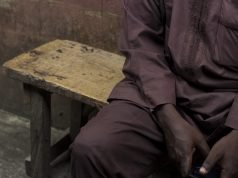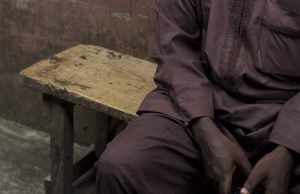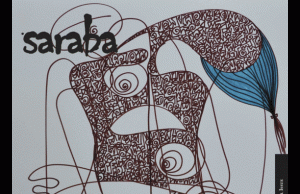That evening as I headed to the Islamic school for kids where I serve as a volunteer, I took the paths through a bushy terrain. My camera hanging on my side, I thought that I might chance upon a remarkable scene to photograph.
A man with a camera in a relatively strange land is always a tourist. An otherwise glum terrain can readily become wondrous in his eyes. Unremarkable bush paths may quite easily find animation by his camera. Such was my encounter in Lokoja. Bushy paths were luxury and contemplating fresh green leaves, green mountainous heights and ceaselessly flying birds brought serendipity. Sometimes, brushing through the thick bush, my camera wouldn’t resist the urge of freezing the moment when farmers bent over the labour of their farms, or the moment when men living nearby grabbed their plastic kettles and hurried towards the bush to defecate.
As I floated through the bush paths in Lokoja, relishing the calm evening breeze, a voice called out to me, “Boda, abeg help us.” It was a girl’s voice. I looked in the direction of the voice and found two teenage girls, one in a red dress and the other in a mishmash of orange blouse. Stacks of firewood lay beside them as they awaited someone to help balance the stacks on each of their heads. Firewood gatherers, I surmised.
“Boda, please help us, abeg,” the girl in red repeated, not sure whether I heard her the first time. I was already used to being called “boda” for “brother” by boys and girls in the vicinity. I sidled towards them. Seeing that I agreed to help them out, they both hastily began tying up the wood stacks with ropes. I waited. As they expertly tied up the stacks, they began to chat and giggle at each other. I watched and pretended that I wasn’t paying attention to them. Before long, the stacks of firewood were all neatly tied up into two hefty bundles. The firmness of the bundles confirmed to me that these girls were experienced in what they did. So, I asked what they intended to do with the firewood.
They both said almost immediately as if anticipating my question, “Na for sell.”
“How much will this cost?” I asked, my eyes moving from one face to the other.
“Na 150 naira,” the girl in red answered, her voice hoarse with catarrh. She took her left index finger to block a nostril and forced air out of the other. She sniffled a little and used a rag to clean her nose. I said sorry. She said thank you.
“Your own, nko?” I asked, pointing at the other girl in orange blouse. Her skirt bore patterns, a pleated black and white stripes that stopped at her knee. I noticed that her own stack of firewood was not as big as the girl in red.
“80 naira, sah,” she said. She looked at me and smiled like someone embarrassed for making a dry joke. She started to cough, so violently that I became afraid. The girl in the red went towards her and began to rub her chest gently, repeating a word I assumed meant sorry. I said sorry too and she nodded her head in acknowledgement. I was relieved when she stopped coughing, and, immediately, to my surprise, the two girls began to laugh and laugh and laugh. I watched, baffled.
I was about to ask how often they came to the bush and how much they made per week, when the girl in red shouted in excitement as she pointed to a rat hurrying through some fallen, dry leaves. They both left their bundles of wood and chased after the rat. The rat was too quick for them as it disappeared into a hole. I heard the tweet of a bird and looked up briefly. I surveyed the vast landscape, believing it was playing witness to the spectacle of the girls’ rat chase. My mind strayed once I began surveying the landscape. It travelled around and settled on the lush green mountain in the horizon. Behind the mountain, a foggy, cotton-like cloud hovered. I forgot that I had my camera.
The girls returned from their unsuccessful hunt, still laughing and chatty. They didn’t look alike. There were no traces in their faces to confirm that they were siblings. So, I concluded they were not sisters. They were both dark complexioned, nonetheless. I helped them to balance the bundles on their head. Each bundle was quite heavy and each of the girls struggled at first with the weight of their wares. Finally, they were ready and on the move. We didn’t say goodbye. Here in Lokoja goodbyes didn’t really matter. The last thing they said was thank you, boda, as they made their way in the opposite direction. They were already some few metres away when I remembered my camera hanging on my side. I quickly took three shots, shots of their backs to me.
••
That night, back in my room under the ecstatic influence of Queen’s Bohemian Rhapsody, I began checking through the three pictures of the firewood girls. I wondered why I felt the urge to take their photos, particularly after they turned their backs to me. I told myself that I didn’t take the pictures to please anyone. I just took them to freeze that moment and keep it alive, as such. My encounter with the firewood girls didn’t last more than fifteen minutes, but it felt like an entrenched memory, the kind that could last a lifetime.
Not knowing what to make of the photographs, I began to watch Boko Haram: Journey from an Evil, a fine documentary film narrated by David Oyelowo. It was about the war in Borno State waged by the militant Jihadist group since 2012. It featured Fati Abubakar, a photographer who, in a marvellous way, had opened the city of Maiduguri to us, a place known to be the birthplace of Boko Haram. Her series on Instagram, which she named “Bits of Borno,” was a visual narrative about the survival and struggles of the people of Maiduguri. The media, when it came to war, often focused their attention on the narratives of loss and pain. But Fati the photojournalist walked through the streets, determined to document something beyond loss and agony and trauma. She took inventory of smiles, laughter and the survivalist spirit of her people. When she captured those moments in photos, they came bearing the light of magic. I found in her photographs a charming harmony, filled with all the ingredients of mastery. I saw the wealth of ingenuity in her use of the camera and her sense of timing. I saw beauty and nostalgia in them. Seeing Fati’s photographs filled me with a sense of purpose, of the importance of photographs, of freezing moments, trapping feelings in this technology of vision.
••
By morning, I found myself still engrossed in the photographs of the firewood girls. Not knowing what to do with the photographs or how to think about my encounter, I began surfing the Internet for possibly similar photographs of girls bearing firewood. Teenage girls carrying firewood on their heads, I punched into Google search. All the pictures I found were of black teenage girls in African countries. A few from Asian countries. I revised my search out of curiosity and typed in instead: teenage white girls carrying firewood on their heads. The same result appeared of black teenage girls with logs of firewood on their heads. I stared at the pictures until I grew tired.
I decided to share my photographs in the court of social media. I wanted to know what others would make of the photos, how someone other than me would react to them. So, I sent the photos via WhatsApp to a few writer-friends of mine who were based in Kenya, Nigeria, South Africa, and Ghana. I wanted to know how they would interpret the images. I captioned the images with a question, what do you see?
CB: The love of bright colour. The girl in front dressed in an orange top, and a white, black-striped skirt. The second girl in a red dress, a dress elegant enough to wear to city soirées. There is a hint to a life of hardship (the firewood, the tattered slippers, the callouses on the feet), but that fades into obscurity at the realization that, to these girls, brightness and beauty occupy a central place.
MM: I see a younger and older sister who had known life’s hardship. The young one is more ambitious, the older more cautious, and again, together they make a good combination. The colour shouts—which of course is significant to womanhood—especially the menstrual cycle. The older one is in full red, and the younger one, half red, significant to the levels of maturity in womanhood.
HS: I see two women carrying logs of firewood that will help make the fire to cook food for a ceremony. A wedding, perhaps. They have just gone to buy it and are now taking it home so that the cooking can commence, and the food can be ready in time for when the visitors begin to arrive.
IO: The nature of the procurement of the firewood is what is worrying, the logs are heavy and there is no home in sight, a strong indicator that the girls have come a long way and have a long way to go. Despite the distance, they have to bear the burden on their heads and that is a recipe for stress, a shortened, ungainly neck and an altered gait.
The first thing I noticed about all the comments I received on the image was the ways that all the writers I shared it with looked at it. There was not a single comment that looked the same; neither were their observations. It is amazing how when we look at an image, an array of interpretation floods our mind. Of all the luxuries of photography, it is the freedom that it grants to its audience, the freedom to observe with a wealth of interpretation, the reward it gifts those who care to look with the intent of understanding it—that is most appealing. This was something I was not in the past conscious of until I met those two teenage girls.
Featured image by Ayo Akinyemi.
































